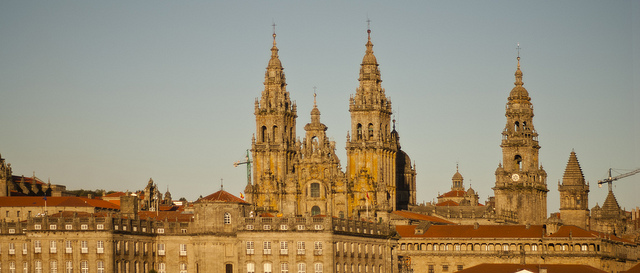
The capital of the green region of Galicia in Spain’s northwest corner, where in addition to Spanish they speak their own language, very similar to Portuguese, called Galego, at first glance Santiago de Compostela might come across as grandiose but also melancholy and grey. That’s partly a function of the weather, which is atypical for “sunny, sunny Spain” – here it’s overcast or rainy much of the year. That certainly didn’t stop the millions of pilgrims who have since the 9th century made this town, later city, their cherished goal, because it’s home to the shrine of Jesus Christ’s apostle St. James (Santiago), where according to tradition his remains are interred. In the Middle Ages, the route from Paris down through the Pyrenees and across northern Spain became known as the Camino de Santiago (Way of St. James), and since the 1980s there’s been a renewal in interest not just among Catholics but also tourists, who undertake parts or all of the route on foot, by bicycle, by car, even by horseback by the tens of thousands each year.
Once they get here, an impressive assemblage of history and architecture awaits, beginning with the Plaza del Obradoiro, site of the iconic cathedral that’s the end of the line for the pilgrims. Daily at midnight the pilgrims’ mass is celebrated here, and sometimes includes the famous flying botafumeiro (which could be translated as “smoke-belcher”), a huge incense-burning contraption swung through the transept (invented centuries ago to mask the the gaggingly ripe odor of unwashed pilgrims, now just kept up for the sake of traditional ritual). The saint’s relices are said to lie beneath the main altar. At the cathedral’s entrance is the Portico of Glory, by a 12th-century sculptor known as Master Mateo (legend has it that if you tap your head against the stone three times, the artist will pass some of his gift to you). Turn around from here and across the square you’ll see the the Hostal of the Catholic Monarchs (now housing one of the network of mostly historic inns known as paradores), the Colegio de San Xerome (university rectorate), and the Raxoi Palace (currently the city hall). You might even hear Galician bagpipes in the distance. An impressive experience indeed.
And it’s true you may have to pull out your umbrella every so often thanks to what they call here the orvallo, a kind of drizzle which is so fine as to be almost unnoticeable but can get you soaked. Roam the cobblestone streets between the historic old town’s stone buildings, stopping off at shops, Baroque buildings, churches, convents, palaces, and pubs for a tapa and a glass of crisp Galician albariño white. Every so often you’ll come across pilgrims, looking disheveled and wearing backpacks, shuffling toward the cathedral; oftentimes people nearby will encourage and applaud them. At the shops, look for tasty souvenirs like tarta de Santiago almond pastry, a creamy herbal liqueur called crema de orujo, and tetilla cheese. Plenty of restaurants and cafés, too, and hereabouts your best bet come mealtime is the local seafood, especially polbo á galega (octopus Galician-style, boiled and drizzled with olive oil).
And Santiago’s not all historic stone – nature is all around. From its hilltop perch, Bonaval Park offers an inspiring view out over the cathedral and the church spires (and next to it modern-art lovers might be interested in a visit to the Galician Contemporary Art Centre). Other lovely local parks include Parque de la Alameda and Mirador de Monte Pío, with another overlook affording a romantic view over Santiago.
Just don’t forget that looks can sometimes be deceiving. What looks tranquil and laid-back by day can turn into party central at night. The old quarter after dark becomes the province of the city’s many university students, who spend more than a few of their evenings on another kind of pilgrimage – in search of a good time. Well, whatever floats your botafumeiro 😉
Useful Facts
- Santiago de Compostela has 95,000 inhabitants and though its total area is 86 square miles (223 square kilometres), its historic centre is quite compact and easily walkable.
- The local climate is chilly and rainy in winter and mild in summer, though clouds can appear at any time.
- Iberia flights from the UK, from the USA.
image | Mario Carvajal

